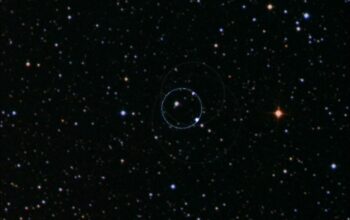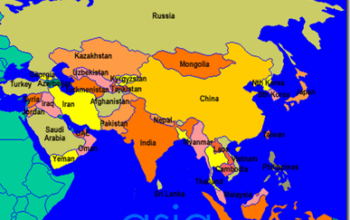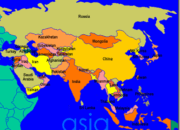As climate dynamics continue to evolve, the intricate interaction between atmospheric processes and marine environments becomes increasingly pertinent. One particularly captivating phenomenon that has emerged in recent discourse is the impact of big waves on sea ice. The playful question arises: Could the burgeoning energy of oceanic waves pose a substantial challenge to the stability of sea ice? This inquiry is not merely rhetorical, but rather an exploration of complex interactions that, when examined, reveal the multifaceted implications of ongoing climate change.
To elucidate this topic, it is essential first to examine the characteristics of sea ice and the mechanisms through which it is formed and maintained. Sea ice is predominantly formed through the freezing of seawater in polar regions, serving as a vital component of the Earth’s climate system. It insulates the ocean from the frigid air above, thereby playing an instrumental role in regulating temperatures and influencing ocean circulation patterns. Moreover, sea ice acts as a habitat for various marine species and birds, underscoring its ecological significance. However, as global temperatures ascend, the stability of this ice cover is increasingly jeopardized.
In parallel, the phenomenon of ocean waves also warrants careful consideration. Waves, generated by wind energy, oscillate across the surface of the ocean and can achieve formidable heights, particularly during storms. These big waves are characterized by their ability to transmit energy over vast distances, leading to significant physical alterations of coastal and marine environments. A question worthy of contemplation is how these waves interact with sea ice, which traditionally has been regarded as a robust, unyielding element of the polar seascape.
The intersection of big waves and sea ice kinetics is a relatively nascent area of inquiry, with many variables at play. For instance, the kinetic energy of a wave increases with both its size and speed. Consequently, when these waves encounter sea ice, they exert tremendous forces that can fracture, displace, or even completely shatter the ice. Studies suggest that during seasonal transitions when sea ice is thinner, the impact of such waves can hasten break-up and thinning, leading to further destabilization of the ice ecosystem.
Additionally, the formulation of a feedback loop must be addressed. As the extent of sea ice diminishes due to warming temperatures and increased wave activity, the underlying ocean water becomes more exposed to the atmosphere, exacerbating temperature variations that perpetuate ice loss. This phenomenon can thus escalate into a self-perpetuating cycle damaging not only the ice but also the global climate, as less reflective ocean surfaces absorb more solar heat, intensifying warming.
Now, we must consider the ecological ramifications of this interaction. Sea ice loss due to big wave action could lead to alterations in the distributions of marine species reliant on ice-covered habitats, including seals, polar bears, and certain seabirds. The implications extend beyond immediate biological responses; ecological shifts may subsequently disrupt food webs and affect Indigenous communities that depend on these species for sustenance and cultural practices.
Moreover, the effects of big waves reach beyond direct impacts on sea ice. The erosion of ice not only influences local ecosystems but also has significant implications for global sea levels. As ice shelves collapse and ice resumes its melt process, fresh water influx into the ocean increases. This could potentially disrupt oceanic currents, leading to cascading repercussions on weather patterns both locally and globally. Such repercussions underscore the intricate interconnectedness of Earth’s systems, where changes in one component can yield far-reaching effects.
From a hydrodynamic perspective, it is crucial to interrogate the interplay between wave dynamics and the boundary conditions imposed by sea ice. The alteration of the wave environment through changes in the ice cover can lead to phenomena such as wave amplification, wherein the energy of incoming waves could increase due to reduced frictional dissipation. Consequently, the potential for more extreme wave activity presents a daunting prospect for the future of polar environments.
Recognizing the significance of this relationship between big waves and sea ice invites a comprehensive inquiry into potential mitigation strategies. As climate change accelerates, understanding the nuanced effects of wave energy on sea ice could guide policies aimed at protecting these delicate ecosystems. Future research efforts should focus on modeling these interactions and incorporating such insights into climate forecasting and resource management strategies.
Furthermore, addressing this challenge requires an interdisciplinary approach, drawing upon expertise from climate science, marine biology, and engineering. Collaborative efforts are essential to create resilient systems capable of adapting to the rapid changes wrought by climate change. Whether these adaptations can stem the tide of destruction remains an open question, one that is critical to address as our planet continues to face unprecedented changes.
In conclusion, the relationship between big waves and sea ice presents a myriad of fascinating questions and urgent challenges in our understanding of climate dynamics. With each passing year, the complexities of this interaction become more pronounced, bearing important implications for marine ecology and global climate patterns. As we endeavor to comprehend these intricate connections, it is imperative to remain vigilant, for the health of our planetary systems hangs in a delicate balance. What further challenges await us from the depths of the oceans? Only time will reveal the answers.










